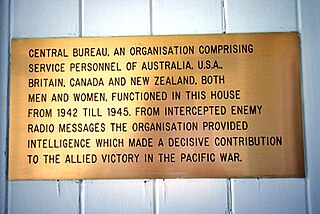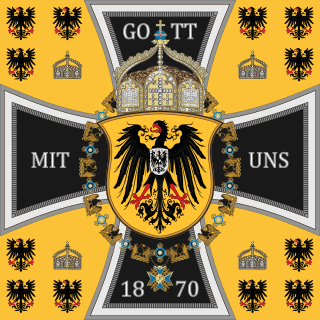Military doctrine is the expression of how military forces contribute to campaigns, major operations, battles, and engagements. A military doctrine outlines what military means should be used, how forces should be structured, where forces should be deployed, and the modes of cooperation between types of forces. "Joint doctrine" refers to the doctrines shared and aligned by multinational forces or joint service operations.

Room 40, also known as 40 O.B., was the cryptanalysis section of the British Admiralty during the First World War.

Karl Konstantin Albrecht Leonhard Graf von Blumenthal was an officer of the Prussian Army and field marshal of the Imperial German Army, chiefly remembered for his decisive intervention at the Battle of Königgrätz in 1866, his victories at Wörth and Weißenburg, and above all his refusal to bombard Paris in 1870 during the siege, of which he was in command.

Gunboat diplomacy is the pursuit of foreign policy objectives with the aid of conspicuous displays of naval power, implying or constituting a direct threat of warfare should terms not be agreeable to the superior force.

The evacuation of East Prussia was the movement of German civilian population and military personnel from East Prussia between 20 January and March 1945, that was initially organized and carried out by state authorities but quickly turned into a chaotic flight from the Red Army.

Thomas Currie "Diver" Derrick, was an Australian soldier and a recipient of the Victoria Cross, the highest decoration for gallantry "in the face of the enemy" awarded to members of the British and Commonwealth armed forces. In November 1943, during the Second World War, Derrick was awarded the Victoria Cross for his assault on a heavily defended Japanese position at Sattelberg, New Guinea. During the engagement, he scaled a cliff face while under heavy fire and silenced seven machine gun posts, before leading his platoon in a charge that destroyed a further three.
OP-20-G or "Office of Chief Of Naval Operations (OPNAV), 20th Division of the Office of Naval Communications, G Section / Communications Security", was the U.S. Navy's signals intelligence and cryptanalysis group during World War II. Its mission was to intercept, decrypt, and analyze naval communications from Japanese, German, and Italian navies. In addition OP-20-G also copied diplomatic messages of many foreign governments. The majority of the section's effort was directed towards Japan and included breaking the early Japanese "Blue" book fleet code. This was made possible by intercept and High Frequency Direction Finder (HFDF) sites in the Pacific, Atlantic, and continental U.S., as well as a Japanese telegraphic code school for radio operators in Washington, D.C.

A military staff or general staff is a group of officers, enlisted and civilian staff who serve the commander of a division or other large military unit in their command and control role through planning, analysis, and information gathering, as well as by relaying, coordinating, and supervising the execution of their plans and orders, especially in case of multiple simultaneous and rapidly changing complex operations. They are organised into functional groups such as administration, logistics, operations, intelligence, training, etc. They provide multi-directional flow of information between a commanding officer, subordinate military units and other stakeholders. A centralised general staff results in tighter top-down control but requires larger staff at headquarters (HQ) and reduces accuracy of orientation of field operations, whereas a decentralised general staff results in enhanced situational focus, personal initiative, speed of localised action, OODA loop, and improved accuracy of orientation.
Mission-type tactics is a method of command and delegation where the military commander gives subordinate leaders a clearly-defined objective, high-level details such as a timeframe, and the forces needed to accomplish that objective. The subordinate leaders are given the planning initiative and freedom of execution: they decide on the methods to achieve the objective independently. This allows a high degree of flexibility at the operational and tactical levels of command, which allows for faster decision-making on the ground and frees the higher leadership from managing the tactical details to concentrate on the strategic picture.

Pigeon post is the use of homing pigeons to carry messages. Pigeons are effective as messengers due to their natural homing abilities. The pigeons are transported to a destination in cages, where they are attached with messages, then the pigeon naturally flies back to its home where the recipient could read the message. They have been used in many places around the world. Pigeons have also been used to great effect in military situations, and are in this case referred to as war pigeons.

The Central Bureau was one of two Allied signals intelligence (SIGINT) organisations in the South West Pacific area (SWPA) during World War II. Central Bureau was attached to the headquarters of the Supreme Commander, Southwest Pacific Area, General Douglas MacArthur. The role of the Bureau was to research and decrypt intercepted Imperial Japanese Army traffic and work in close co-operation with other SIGINT centers in the United States, United Kingdom and India. Air activities included both army and navy air forces, as there was no independent Japanese air force.

Psychological operations (PSYOP) are operations to convey selected information and indicators to audiences to influence their motives and objective reasoning, and ultimately the behavior of governments, organizations, groups, and large foreign powers.

Lieutenant General Sir Stanley George Savige, was an Australian Army soldier and officer who served in the First World War and Second World War.

The Imperial German Army (1871–1919), officially referred to as the German Army, was the unified ground and air force of the German Empire. It was established in 1871 with the political unification of Germany under the leadership of Prussia, and was dissolved in 1919, after the defeat of the German Empire in World War I (1914–1918). In the Federal Republic of Germany, the term Deutsches Heer refers to the German Army, the land component of the Bundeswehr.

Lieutenant General Sir Henry Wells, was a senior officer in the Australian Army. Serving as Chief of the General Staff from 1954 to 1958, Wells' career culminated with his appointment as the first Chairman, Chiefs of Staff Committee, a position marking him as the professional head of the Australian Military. He served in this capacity from March 1958 until March 1959, when he retired from the army.
Fleet Command is responsible for the command, operations, readiness, training and force generation of all ships, submarines, aircraft squadrons, diving teams, and shore establishments of the Royal Australian Navy. Fleet Command is headquartered at HMAS Kuttabul in Sydney, and is led by the Commander Australian Fleet (COMAUSFLT), also referred to as Fleet Commander Australia (FCAUST), which is a rear admiral (two-star) appointment.

The Australian contribution to the Battle of Normandy involved more than 3,000 military personnel serving under British command. The majority of these personnel were members of the Royal Australian Air Force (RAAF), though smaller numbers of Australians serving with the Royal Navy and British Army also participated in the fighting prior to and after the Allied landings on 6 June 1944. While all the RAAF units based in the United Kingdom (UK) took part in the battle, Australians made up only a small portion of the Allied force.

The Nix class was a pair of avisos built for the Prussian Navy in the early 1850s. The class comprised two ships: SMS Nix and Salamander. They were ordered as part of a modest program to strengthen the fleet at the urging of Prince Adalbert of Prussia in the immediate aftermath of the First Schleswig War, which had demonstrated that the weak fleet could not challenge the ability of Denmark to impose a blockade of Prussian and German ports. They were small vessels with a shallow draft, since they were intended to operate close to shore to defend Prussia's coast. Neither vessel saw significant service in the Prussian Navy before being sold to the British Royal Navy in exchange for the frigate Thetis in 1855. They were renamed Weser and Recruit, respectively, and the former saw action during the Crimean War in the Black Sea later in 1855. The two ships saw little activity after their sale to Britain, with Recruit being laid up in 1861 and Weser following in 1865. Recruit was sold for merchant service in 1870, while Weser was discarded in 1873.
The XXI Army Corps, also at times designated Group Falkenhorst and Group XXI, was a corps of the German Heer during World War II. It was first deployed on 10 August 1939 in Wehrkreis I in East Prussia. It participated in Operation Weserübung in early 1940. Later that year, it became Armeegruppe XXI. In 1941, the XXI Army Corps was restructured to an army-level unit, Armee Norwegen. In 1943, another corps-level unit carrying the ordinal number 21 was created, the XXI Mountain Corps.

The siege of Phalsbourg was an early battle of the Franco-Prussian War that was fought between the French Empire against Germany at Phalsbourg near the Vosges beginning on 10 August 1870, and ending on 12 December of the same year.














